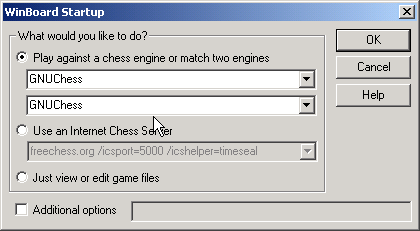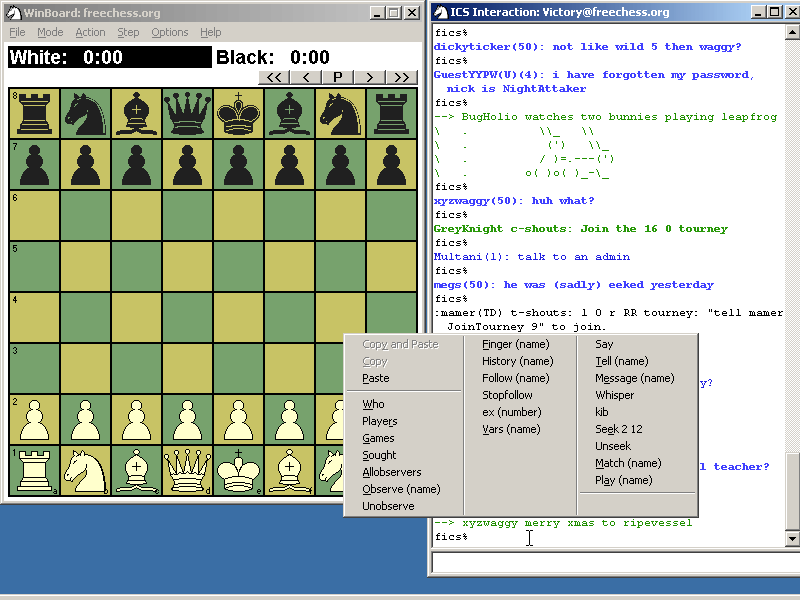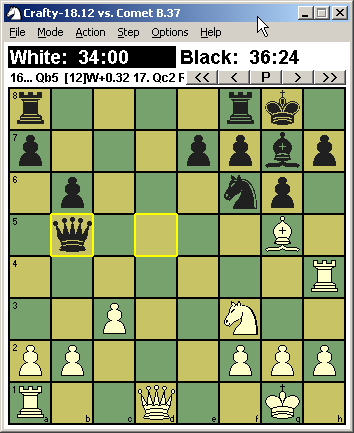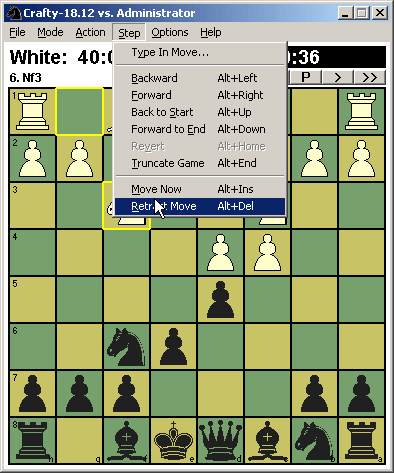|
|
| Monitor page for changes |
by ChangeDetection |

|
|
|
||||||

|
When I first began my FAQ on Winboard 1 and Chess engines, my aim was to systematically catalogue information and knowledge regarding the use of Chess engines in Winboard that was floating around in various Web pages and forums and organise them together as best as I can on one site. As a result, I focused overly on the "Hows" and to a lesser extent the "What is" questions regarding the use of Winboard. By doing so, I tacitly assumed that my readers knew WHY they wanted to use it.
However, recently I realise that there is a large majority audience who have never heard about Winboard, or for those who have , few have any clear idea about the capabilities and limitations of the use of Chess engines in Winboard. Some, perhaps attracted by the idea of downloading tons of free Winboard engines, have over-inflated expectations about What Winboard can do. Given that configuring Winboard to accept Winboard Chess engines is not easy for many new users, I feel that it would be best for them to actually understand what Winboard can and cannot do before plunging in on a fairly time consuming task and risk disappointment when they realise that Winboard fails to meet their expectations.
As such this article is my attempt to plug what I perceive to be a fundamental gap in my Web page, by explaining as clearly as I can, the reasons for using Winboard and perhaps equally importantly, reasons to look for another software besides Winboard.
Many descriptions of Winboard, I have read, mention three main functions of Winboard.

The 3 options you get when starting Winboard
I have changed the order which I present the functions of Winboard (compared to the order you see in the startup dialog box) because I have a lot more to say about Winboard as a GUI for Chess engines.
The first two functions (using my ordering) for most part do not require much effort on the part of the user to configure, but since they are part of the complete package you get in Winboard I will cover them as well.
However regardless of the reason you wish to use Winboard for, you have to be comfortable with messing around with setup files [mostly text files], to get the most out of Winboard. This is usually not a problem for most users, but it can throw some people off, especially those who are used to the ability to change everything within the interface.
Firstly, like most Chess software today, Winboard supports the PGN [Portable Game Notation] Standard as well as the related EPD [extended position description] which is used to store Chess games. As such, you can load and save games in those formats. Winboard plus [now incorporated in Winboard] also introduced a nice feature that allowed you to copy and paste games and positions from the clipboard to Winboard and vice-versa.

However, Winboard cannot take the place of a Chess database package.
The latter is not such a big problem, since PGN files are merely text files, and you can simply cut and paste the games you want using a text editor, but if you are looking for a full search capabilities, you are better off looking at a commercial package like Chessbase. Free Chess databases for download include the Chessbase Light [limited to 8000 games] , Chess Assistant demo ,SCID (with Winboard Chess engine support). I also highly recommend Chesspad a free and lightweight [in terms of size] program that has adequate database features and Winboard engine support.[Altough it seems analysis doesn't work except for Crafty]

If you play primarily in YahooChess 2 , you must be familiar with the Javaboard, that allows you to play Chess in your Web browser without downloading anything. But in ICC and FICS , most users prefer to use a Chess playing Client, which is generally faster and provides more features than just using Javaboard.In particular, Winboard is a extremely popular Chess playing client in FICS.
However it's not the only choice, some users prefer Chess Client/cclient , Chessbd/Slics , Chessmachine (including patch ) and Thief . I personally feel that, Winboard is a very flexible interface, but to get the most of it requires quite a bit of configuring around with the Winboard.ini file.You might want to refer to Edward Collin's Tribute to Winboard page . If you are lazy like me you might prefer using CClient or Chessmachine, both of which allow you to change the configuration /settings within the GUI. Other features that Winboard lack include
You might want to check out other interfaces at http://www.freechess.org. This is especially true if you wish to play Bughouse in which case Thief is ideal
A very good reason for using Winboard though, is if you want to set up a automated Chess computer playing account. By using zippy together with Winboard, you can allow any Winboard engine to play automatically on the chess servers 3. Interestingly enough with the UCI to Winboard adaptor by Roland Pfister you can now "adapt" UCI engines to Winboard, which of course makes the use of zippy possible now for UCI only engines like Shredder.

This is the feature that is unique to Winboard and the main topic on which my whole FAQ is based on.
The ability of Winboard to support and run various Chess engines is probably the most attractive feature in Winboard.However, interestingly enough, Winboard, was only meant to be a graphical interface for GNUchess. This followed by the addition of zippy, allowed GNUchess to run automatically on Internet Chess servers in 1992. However authors of other Chess programs soon began to realise the possibility and advantage of porting their programs into Winboard. This seemed possible given that GNUChess and Winboard itself were separate programs. They began to ask Tim Mann for instructions on how to make their programs compatible. As time went by, an ad hoc protocol was built that is today known as the Winboard protocol which is used by all Winboard Chess engines to communicate with Winboard 4 .
Today as at time of writing [24-05-2001] there are close to 100 Chess engines that can run in Winboard. The vast majority are free for download, but Chess engines such as Gandalf, Patzer, Lambchop, Capture have gone commercial as part of the Winboard edition package of Gambitsoft and it's possible we will see more of such commercial engines.See Section [A.4] for a updated list of commercial Winboard engines.
In many ways, the Winboard protocol can be said to be the facto- standard of Chess engines such that even commercial packages like Chessmaster, Chessbase, Chess assistant, ChessVision, Chess Academy etc now all support the use of Winboard engines.
But how does Winboard actually interact with the various Chess engines? In case, you are still unclear, here's a rough layman's idea of how it works. I shall use the well known Chess program Crafty as a example. When you download Crafty.exe, and run it, all you get is a text based ascii board, where you have to enter moves using the keyboard.There is no graphics, no pulldown menus, nothing in fact but a text interface for you to type your moves and commands. Obviously this is not very user-friendly.
But fortunately, you can run Crafty in Winboard, and get access to functional graphical interface provided by Winboard. When you run Crafty in Winboard, Crafty.exe still runs in the background to decide what move to make, but the move Crafty decides on will be relayed to Winboard and displayed on the Chessboard of Winboard. Similarly, when you make a move on Winboard's graphical board, Winboard will relay your move back to Crafty which will then spend time thinking about the best answer to your move before relaying it back and so on so forth. All this is done so seamlessly in the background that Crafty and Winboard seem to act like one complete package. In fact, Crafty itself can be replaced by any of the other 100 Chess engines [A term used to refer to the Chess playing portion of the package, you can think of it has the "brain" that actually plays Chess] and the user will still not notice a difference [beyond the different moves of course].

The other amazing aspect of Winboard is that once you have installed various Winboard compatible engines, there is no reason why you need to play only human versus computer matches through Winboard. In fact you can replace the human with another computer engine and run a automated computer chess games between 2 such engines with Winboard. This is obviously very attractive if you want to run billions of automated Chess matches against 2 programs, to gauge their strength.
All this sounds very exciting of course, but I must warn users from expecting too much from Winboard. It must be noted that Winboard acts as a standardised interface and supports many Chess engines, as such, it supports only the bare minimum features needed to play a game. Still it has a fair number of impressive features. You can


But beyond that, there are not many other features [especially graphical frills] you would expect from a modern Computer Chess playing package like Fritz or Chessmaster.
For example, among the things that Winboard cannot do include:
The last weakness is probably most disappointing to people who want the benefit of using a variety of Chess engines to analyse their games. But as I mentioned before Winboard is not a database package and you are perhaps better off with commercial database packages like Chess assistant that support Winboard engines.
If having read all these, and you are still willing to try your hand at Winboard and Winboard engines, I wish you all the best and hope to see you around!
Sincerely,
Aaron Tay| |
Home | Articles | Links | Guestbook | Poll | Email | Bookmark |
|
||||
| Section A | Section B | Section C | Section D | Section E | Section F |